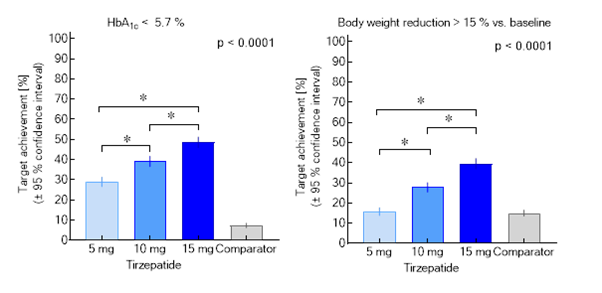For patients with type 2 diabetes or obesity, tirzepatide offers near-healthy blood glucose control and significant weight loss.
Incretin-based medications, making use of the glucose- and weight-lowering effects of the gut hormone glucagon-like peptide-1 (GLP-1), have transformed treatment for type 2 diabetes. They work as well as or better than insulin therapy in terms of plasma glucose levels and associated laboratory data (e.g., glycated haemoglobin; HbA1c) while dodging potential hypoglycemic episodes, plus they come with the bonus of weight loss. Now, a new drug has been developed that activates receptors not only for GLP-1 but also for GIP, the second main incretin hormone.
It was unexpected that 'twincretin', a single molecule capable of strongly activating both incretin receptors, would be much more effective in stabilising blood sugar and reducing body weight than GLP-1 receptor agonists which solely interact with the GLP-1 receptor. Noteworthily, a great number of patients achieved normal HbA1c-values (Figure). Previously, diabetes experts would often set targets 15-20 % higher than the usual range; however, with 'tirzepatide', it is now possible to surpass these goals without any risk for hypoglycaemia.
Typically, a weight loss of more than 15 percent off baseline body weight is achieved (Figure). As a result of diet restrictions, weight-loss trials often lead to diabetes remission (the absence of evidence for an illness previously present). Currently, there is debate over whether such a "on drug" remission can be used to predict the same benefits as those achieved by patients who do not receive medical treatment for their hyperglycemia.
Tirzepatide is revolutionizing the diabetes field. The SURPASS and SURMOUNT studies indicate normalized glucose concentrations can help curb the onset of diabetes complications. Despite being a current hot commodity, its production is limited so far, which makes further research into optimal glycaemic targets (even into the normal range) difficult. Questions persist as to whether jointly lowering both baseline glucose and body weight can prevent diabetes better than sugar control alone. Tirzepatide has the potential to challenge established diabetology protocols and may ultimately simplify life for people with type 2 diabetes while extending it.

Figure. Proportions of patients achieving the targets of a glycated haemoglobin < 5.7 % (equivalent to a normal glucose metabolism) or a body weight reduction > 15 %. A meta-analysis summarizing SURPASS 1-5 (based on results of the efficacy estimand) is shown. Asterisks indicate significant differences between doses of tirzepatide (mg per week injected subcutaneously).